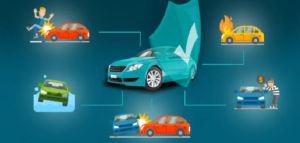What kind of insurance do I need to drive in Ohio?

Nowadays, it’s a very common question: What kind of insurance do I need to drive in Ohio? Today, we will discuss car insurance coverage in Ohio. Types of Ohio’s auto insurance coverage, Ohio’s car insurance cost, Auto insurance claim process, and ways to reduce auto insurance costs in Ohio. In Ohio, third-party liability coverage is the most basic kind of auto insurance, and it is required. It shields you from having to pay for any damages to someone else’s property as the policyholder. If you cause an accident that results in someone being hurt or killed, you will also be covered.
Types of Ohio’s auto insurance coverage

In Ohio, the minimum coverage amount for auto insurance is $25,000/$50,000/$25,000. Your limitations for physical harm in the case of a covered accident are $25,000 per person, up to a total of $50,000 per incident. Additionally, it pays up to $25,000 for property damage caused by third parties.
Ohio minimal standards for auto insurance Liability insurance, which covers both property damage and physical injury, is a need for a minimum Ohio auto insurance policy. The costs you will bear if you cause an accident and are determined to be at fault are covered by liability insurance.
- Liability Coverage: This is mandatory in Ohio and includes:
- Bodily Injury Liability: Covers injuries you cause to others in an accident you are responsible for. Bodily injury (BI): $25,000/person, $50,000/accidentRequirement
- Up to $25,000 per injured person
- Up to $50,000 per accident for two or more injured persons, combined
Covers
- Your assets
- Legal fees in the event the other party sues you, up to the stated limit
Does not cover
- Your medical bills
- Property Damage Liability: This covers damages to someone else’s property caused by your vehicle.
Property damage (PD): $25,000/accident
Requirement
- Up to $25,000 per accident
- No more than $50,000 for each accident
Covers
- Everything from the other driver’s car that’s damaged
- Other property that is damaged in the accident (buildings, fences, etc.)
- Bodily Injury Liability: Covers injuries you cause to others in an accident you are responsible for. Bodily injury (BI): $25,000/person, $50,000/accidentRequirement
- Uninsured/Underinsured Motorist Coverage: Protects you if you’re in an accident with a driver who doesn’t have insurance or doesn’t have enough coverage to pay for your damages.
- Medical Payments Coverage (MedPay): Optional coverage that pays for medical expenses resulting from an accident, regardless of fault.
- Personal Injury Protection (PIP): Optional coverage that covers medical expenses, lost wages, and other expenses for you and your passengers, regardless of fault.
- Collision Coverage: Pays for damage to your vehicle resulting from a collision with another vehicle or object.
- Comprehensive Coverage: This covers damage to your vehicle from non-collision incidents, like theft, vandalism, fire, or natural disasters.
- Towing and Labor Coverage: Optional coverage that reimburses you for towing and labor costs if your car breaks down.
Ohio’s car insurance cost?

Ohio’s Average Auto Insurance Cost by Age
It’s a given that your costs for auto insurance will increase with age. Young drivers typically pay more for auto insurance because insurance companies view them as less responsible.
In Ohio, a motorist who is 16 years old pays $4,659 for auto insurance annually, while a driver who is between the ages of 50 and 59 only pays $884.
| Age | Average Annual Premium |
| 16 | $4,658.99 |
| 17 | $4,439.97 |
| 18 | $4,012.79 |
| 19 | $2,735.48 |
| 20s | $1,446.60 |
| 30s | $1,001.11 |
| 40s | $966.80 |
| 50s | $884.36 |
| 60s | $907.23 |
| 70s | $1,108.52 |
If you’re worried about getting insurance for a teenage driver, take this into account: Ohio ranks as the fifth most affordable state for 16-year-olds to purchase auto insurance.
Ohio’s Average Auto Insurance Costs by Gender
Insurance firms use gender as a rating component even though it has less of an effect on auto insurance rates than location or age.
| Gender | Average Annual Premium |
| Male | $1,015.93 |
| Female | $1,026.99 |
Ohio’s Average Car Insurance Rates by Marital Status
A benefit of marriage is that you might be able to obtain a better bargain on your auto insurance policy, on top of the wedding presents. Married drivers in Ohio save $44 on auto insurance annually. This is not as much as the $76 US post-nuptial discount.
| Marital Status | Average Annual Rate |
| Single | $1,015.93 |
| Married | $971.83 |
| Divorced | $1,015.93 |
| Widowed | $1,008.29 |
Ohio’s Average Auto Insurance Costs by Credit Tier
Credit history is one factor that auto insurance companies use to estimate a customer’s reliability. According to data, drivers with excellent credit are more trustworthy customers for auto insurance since they make claims less frequently, leaving the insurance company on the hook.
In Ohio, the annual cost of auto insurance can be reduced by $1,024.52 for a driver with good credit as opposed to one with bad credit. Learn more about how credit score affects the cost of auto insurance:
| Credit Quality | Average Annual Rate |
| Very Poor (300-579) | $1,898.03 |
| Fair (580-669) | $1,559.16 |
| Good (670-739) | $1,303.67 |
| Very Good (740-799) | $1,075.20 |
| Exceptional (800-850) | $873.51 |
Ohio’s Average Auto Insurance Prices for High-Risk Drivers
Your auto insurance premiums will undoubtedly increase if you’ve been found guilty of an on-road infraction or found to be at fault in an accident. Your auto insurance will cost higher the more infractions you accrue.
In Ohio, your annual rate for auto insurance will increase by $520.31 after your first minor at-fault collision. In Ohio, a DUI or DWI is one of the most serious driving offenses and can increase your annual insurance rates by an average of $673.87.
| Age | Average Yearly Premium |
| DUI or DWI | $1,711.04 |
| Reckless Driving | $1,568.46 |
| At-Fault Accident (<$1,000) | $1,557.48 |
| At-Fault Accident ($1,000-$2,000) | $1,593.32 |
| At-Fault Accident (>$2,000) | $1,557.48 |
| Open Container | $1,375.80 |
| Speeding (21-25 MPH > limit) | $1,243.87 |
| Speeding (16-20 MPH > limit) | $1,243.87 |
Ohio’s Average Auto Insurance Prices by Coverage Level
The amount of coverage you choose will determine how much you pay each month for your auto insurance. Comprehensive coverage with a smaller deductible is typically more expensive than liability-only coverage. The difference in premiums for comprehensive coverage with a $500 deductible and liability-only coverage in Ohio is $573.
| Coverage Level | Average Yearly Rate |
| $100K/$300K/$100K Bodily Injury/Property Damage — Liability Only | $512 |
| $100K/$300K/$100K Bodily Injury/Property Damage — $1,000 Comprehensive/Collision | $922 |
| $100K/$300K/$100K Bodily Injury/Property Damage — $500 Comprehensive/Collision | $1,071 |
| $50K/$100K/$50K Bodily Injury/Property Damage — Liability Only | $459 |
| $50K/$100K/$50K Bodily Injury/Property Damage — $1,000 Comprehensive/Collision | $870 |
| $50K/$100K/$50K Bodily Injury/Property Damage — $500 Comprehensive/Collision | $1,018 |
| State Minimum — Liability Only | $429 |
| State Minimum — $1,000 Comprehensive/Collision | $848 |
| State Minimum — $500 Comprehensive/Collision | $1,002 |
Ways to Reduce Auto Insurance Costs in Ohio

- Compare Quotes: Obtain quotes from multiple insurance providers. Each company uses its formula to determine rates, so prices can vary significantly.
- Bundle Policies: Consider bundling your auto insurance with other policies, such as homeowners or renters insurance, to potentially qualify for a discount.
- Increased Deductibles: A higher deductible usually leads to lower premiums. Just be sure you can comfortably afford the deductible in case of a claim.
- Maintain a Good Driving Record: Safe driving can contribute to lower premiums. Avoid accidents and traffic violations to keep your rates down.
- Ask About Discounts: Inquire about discounts for safe driving, good grades (if applicable), and other factors that may apply to you.
- Drive a Safe and Affordable Car: The type of car you drive can impact insurance costs. Generally, safer and less expensive cars have lower insurance premiums.
- Consider Your Coverage Needs: While looking for affordability, ensure that the coverage meets your needs. Full coverage typically includes liability, comprehensive, and collision coverage.
Don’t forget to customize your insurance to meet your unique needs and circumstances. Reviewing your policy regularly and comparing quotes will help you make sure you’re getting the greatest value.
Auto insurance claim process
Report the Incident: The first thing you should do after an accident or damage is to notify your insurance provider. Usually, you can accomplish this by calling the insurer’s claims hotline, utilizing a mobile app, or going online. Give specifics like the incident’s description, date, time, and location.
Information Exchange: Share details with the people involved, such as names, contact information, insurance information, and car data. Get the details of any witnesses, if there are any. Document the scene with photos, if possible, to provide visual evidence.
File a Police Report: It is wise to make a police report in certain situations, particularly if there are injuries or substantial damage. When processing the insurance claim and assigning blame, this document may be very important.
Claim Adjuster Assessment: The insurance company assigns a claims adjuster to your case. The adjuster will investigate the incident, review the police report, inspect the damages, and assess the costs involved. They may also interview involved parties and witnesses.
Estimate and Repair: The insurance company evaluates the adjuster’s findings to determine whether to declare the car a total loss or to issue an estimate for repairs. The repairs will start if the estimate is approved. While some insurers let you select the repair shop, others have preferred shops.
Medical Claims: If injuries occur, the medical claims procedure starts. This entails providing the insurance company with medical bills, records, and other pertinent paperwork. The kind of insurance and state laws will determine what is and is not covered for medical costs.
Resolution and Payment: The insurance provider will make a payout after the evaluation and repair procedures are finished. This can entail paying for repairs, paying for a totaled car, or paying for medical bills. The resolution process may take several weeks.
Appeals Process: If you disagree with the insurance company’s decision, there’s usually an appeals process. This may involve providing additional documentation or appealing to a higher authority within the insurance company.
The procedure for filing a car insurance claim is intended to assist people in getting over mishaps or unforeseen circumstances. Throughout the whole claims process, it is imperative that you adhere to the procedure exactly, give accurate information, and communicate with your insurance carrier clearly and concisely.
Some advice for accelerating your auto insurance claim
Here are some pointers to speed up the process of filing a claim on your auto insurance.
Download the mobile app for your insurance: Through their applications, a lot of auto insurance companies let drivers submit claims. While each company’s app may have different features and usability, many allow you to attach files such as written statements, images, and supporting evidence to support your claim. Certain applications facilitate the tracking of your claim’s progress.
Compile the required data before submitting the claim: When making a car insurance claim, the more organized you are, the faster you will find the information you need. Delays may result from omitting important information, missing uploading accident images, or not mentioning the other driver’s insurance.
Remember when things are due: The type of auto insurance claim, the insurer, and the location all affect the filing deadlines. As soon as you can after an accident, get in touch with your motor insurance provider to find out if there are any deadlines for submitting paperwork and submitting a claim. To ensure that you don’t forget the deadline, add these to your paper or digital calendar and, if at all possible, attach an alert.
Contact your auto insurance provider again. The severity of the collision, whether more than one motorist was involved, and the amount of time it takes the adjuster to go through all the paperwork can all affect how quickly a claim is settled. It’s easier to make sure everything is on track for settlement if you follow up with your insurance.
Common Myths and Misconceptions About Car Insurance
A lot of myths and misconceptions surround the subject of auto insurance. These false beliefs have the potential to confuse and, occasionally, to cause people to make poor decisions for themselves. Let’s dispel some of these widespread rumors and clear up any misunderstandings regarding auto insurance.
1. Myth: Red cars cost more to insure: The idea that red automobiles cost extra to insure is frequently spread. The truth is that your car’s color has no bearing on your insurance costs. A driver’s history and vehicle make, model, and year are of greater interest to insurers.
2. Myth: Minimum Coverage is Always Sufficient: Some people think it’s always sufficient to choose the bare minimum of coverage. However, in the event of a serious accident, basic coverage might not provide you with enough protection. To improve your financial security, it’s critical to evaluate your unique demands and take into account supplemental coverage.
3. Myth: Your Insurance Covers Everything: Although insurance offers necessary protection, it does not cover every eventuality. It’s important to know the restrictions of your policy. Generally speaking, things like normal wear and tear, mechanical malfunctions, or deliberate destruction are not covered.
4. Myth: Personal Auto Insurance Covers Business Use: Personal auto insurance coverage may not protect you if you use your car for work-related travels. Commercial auto insurance is frequently necessary for business use to guarantee adequate coverage in the event of work-related accidents.
5. Myth: Older Drivers Always Pay More: Many insurance companies give senior citizens discounts, despite the common misconception that older drivers always pay higher prices. Older drivers can frequently receive reduced rates due to their experience and safe driving records.
Clarifying Misconceptions:
1. Misconception: Speeding Tickets Don’t Affect Rates Significantly: Some people believe that a single speeding ticket won’t have a big effect on insurance costs. In actuality, fines for speeding can result in higher insurance rates, and more expensive rates may follow subsequent infractions. To keep insurance costs low, driving safely must be your top priority.
2. Misconception: Credit Score Doesn’t Affect Auto Insurance: Your credit score indeed affects how much your auto insurance costs. Credit history is a common tool insurers use to evaluate a policyholder’s dependability. Better credit makes one more trustworthy and might result in lower insurance costs.
3. Misconception: Comprehensive Coverage Covers Everything: Even though comprehensive coverage is broad, it doesn’t address every eventuality that could arise. It is essential to comprehend the precise contents and exclusions of your policy. For instance, it usually doesn’t cover routine upkeep or mechanical failures.
It’s critical to bust these myths and clear up misunderstandings to make knowledgeable judgments about auto insurance. Policyholders can ensure they have the appropriate protection for their needs and can navigate the market more skillfully by being aware of the reality of insurance coverage.
I believe if you can observe my entire blog, you may get a valid idea of car insurance coverage in Ohio. Types of Ohio’s auto insurance coverage, Ohio’s car insurance cost, Auto insurance claim process, and ways to reduce auto insurance costs in Ohio.
